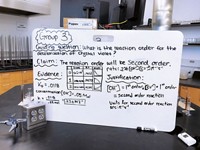Advertisement
Grab your lab coat. Let's get started
Welcome!
Welcome!
Create an account below to get 6 C&EN articles per month, receive newsletters and more - all free.
It seems this is your first time logging in online. Please enter the following information to continue.
As an ACS member you automatically get access to this site. All we need is few more details to create your reading experience.
Not you? Sign in with a different account.
Not you? Sign in with a different account.
ERROR 1
ERROR 1
ERROR 2
ERROR 2
ERROR 2
ERROR 2
ERROR 2
Password and Confirm password must match.
If you have an ACS member number, please enter it here so we can link this account to your membership. (optional)
ERROR 2
ACS values your privacy. By submitting your information, you are gaining access to C&EN and subscribing to our weekly newsletter. We use the information you provide to make your reading experience better, and we will never sell your data to third party members.
Undergraduate Education
Movers And Shakers
C&EN talks with Joshua Ring, organic chemistry educator
Professor adopted alternative grading strategy to ensure his students master the essentials of organic chemistry
by Celia Henry Arnaud
October 24, 2016
| A version of this story appeared in
Volume 94, Issue 42
A few years after he started teaching in 2008, Joshua Ring, an organic chemistry professor at Lenoir-Rhyne University, began asking himself what he could say with certainty about every student who passed his class. Could he be sure that students had learned the essentials just because they received a particular grade? Or, did his use of partial credit obscure the fact that they might have partially grasped everything while fully mastering nothing?
Vitals
Hometown: Ellicott City, Md.
Position: associate professor of chemistry, Lenoir-Rhyne University
Education: B.S. in chemistry, Georgia Tech; Ph.D. in pharmaceutical science, University of Kentucky
Favorite part of organic chemistry: the puzzle-solving of structure elucidation (especially by NMR)
Hobbies: camping, playing Legos with his daughters and board games with his colleagues
Then, a couple of years ago Ring learned of a possible way to answer those questions. It was a grading strategy called specifications grading, developed by Linda Nilson, a faculty development expert now retired from Clemson University. The system involves a course built around specific, assessable concepts or skills students must learn or be able to do. A teacher assesses students on each of these so-called learning outcomes, and their grade depends on how many outcomes they pass.
Ring first learned about specifications grading when Robert Talbert, a blogger and mathematics professor at Grand Valley State University, gave a presentation at a Lenoir-Rhyne faculty development workday. Talbert was there to talk about “flipping” the classroom, a strategy in which students are introduced to content via short videos outside of class whereas class time is used to work problems. Ring was already doing that. He wanted to know how Talbert graded in such a setting. Talbert told Ring about specifications grading and how it allowed him to stop giving partial credit.
This intrigued Ring. “I was giving a lot of partial credit,” he says. “I spent a lot of time making sure it was fair between students. But there was always this element of no one’s getting this completely right. It was irritating.”
To apply specifications grading to his organic chemistry classes, Ring divided the course material into “essential” and “general” learning outcomes. The essential outcomes involve skills related to understanding Lewis dot structures, naming and drawing structures, identifying and explaining charge stability, drawing reaction mechanisms, and predicting reactive sites. Meanwhile, the general outcomes include skills such as classifying and comparing bonds and angles, identifying and designating chirality, and predicting products of various reactions.
The essentials
Students in Ring’s Organic Chemistry I class must master these six essential outcomes:
Drawing Lewis dot structures
Interconverting Lewis dot structures, condensed formulas, and line-angle structures
Using basic nomenclature
Identifying and explaining charge stability
Drawing reaction mechanisms (acid-base, substitution, addition, elimination)
Predicting reactive sites
Ring tests students on each of the outcomes in five-question tests that take 10 or 12 minutes. An answer is either right or wrong, with no chance for partial credit. To pass an outcome, a student must answer four out of five questions correctly.
No student can pass the class without passing all six essential outcomes, no matter how many general outcomes the student passes. (They’re called essential for a reason.) From there, Ring determines students’ grades by the number of general outcomes passed. Passing three earns a D−. Each outcome beyond that raises a student’s grade by one-third of a letter grade.
In his first iteration in fall 2015, Ring had 22 outcomes—six essential and 16 general. “I think that was too many,” he says. “For this fall, I lowered it to 20, consolidated things, and moved some around.” For example, he moved one general outcome—on the application of intermolecular forces—out of the class and into an associated laboratory class. He still has six essential outcomes, but now he includes only 14 general outcomes.
“By dividing this up into the essential and general outcomes, I know that every single student who passes Organic I understands and has mastered the topics that are baseline to move on to the second semester,” Ring says. “In past years, I had students who ended up with Cs or Ds and moved on to Organic II. It turns out that the subjects they did well enough to pass were not really the most important things.”
Because Ring flips his class, students are first introduced to material online. After a brief introduction and enumeration of learning goals for a specific outcome, students watch a video and work practice problems. Then, in class, they work more problems in groups with Ring’s guidance. Each outcome takes one or two class periods. Students take the test for a given outcome at the beginning of the next class period after the end of a unit. So students end up taking these short tests every second or third class period.
Ring no longer gives traditional midterm exams. Instead, those periods are reserved for retaking exams for outcomes students might not have passed the first time. For an hour-long exam period, students can retake up to six tests.
Ring divides the two hours allotted for the final exam in half. For the first hour, everybody takes a cumulative test. In the second hour, students again have the chance to retake any outcomes they have not yet passed. As with the outcome tests, Ring gives no partial credit on the final. For most students, they leave the final exam with the same grade they earned based on the number of outcomes they passed during the term. For students who do particularly well, or particularly poorly, the cumulative test can raise or lower their final grades by up to the equivalent of two outcomes.
When Ring first used specifications grading last fall, he was disappointed that the average grade on the final was about the same as the year before. But then he regraded the 2014 exams without assigning partial credit and found that the students in 2015 did significantly better.
“This is probably what I would have expected if I had guessed,” Ring says. The earlier students had gotten 40% right and another 20% on partial credit. Ring says the new method allows him to know exactly what his students have learned completely.
Students have responded positively to the new grading scheme, Ring says. “One of the most common things I heard was students complaining about why other professors gave them big tests that covered so much material,” he says. “That’s what I did forever, and that’s the standard way to do it. I don’t think there’s anything wrong with that. It’s just different.”
Students benefit in other ways too, Ring says. Because the tests are more frequent but more focused, much of students’ test anxiety seems to be eliminated, he says. Plus, the frequent tests encourage students to keep on top of the work. And the opportunity to retake outcome tests allows students to learn from their mistakes. In that way, a failed test takes on less of a sign of failure and more of a sense of “you haven’t mastered this yet,” Ring says.
Ring wonders whether specifications grading could be implemented across the chemistry program at the school. “I wish there were things that students for sure had mastered coming out of gen chem,” before taking organic chemistry, he says. “I think it would be cool to do it programmatically, but I’d like to have more evidence of how well it works for long-term learning with a larger sample size before trying to push it.”






Join the conversation
Contact the reporter
Submit a Letter to the Editor for publication
Engage with us on Twitter